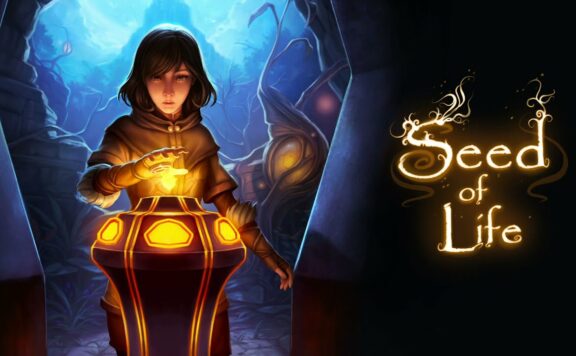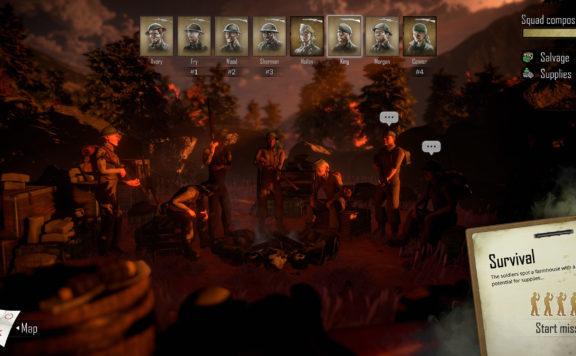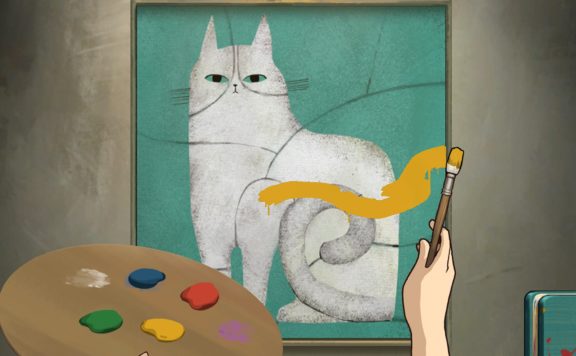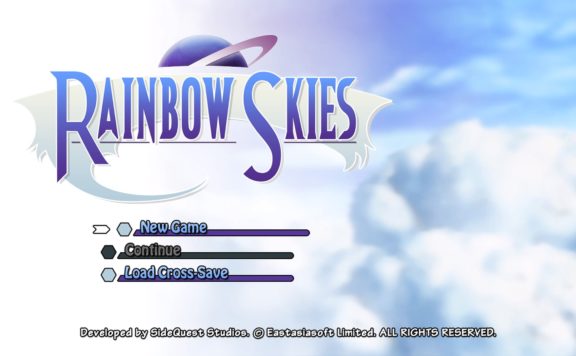Broken Lines is an upcoming story-driven game based around the experiences of eight soldiers. We had the opportunity to chat with Creative Director Hans von Knut Skovfoged from PortaPlay to learn more about the game and what players can expect. Check out our Broken Lines interview.
Gamespace: In your own words what is Broken Lines?
Hans von Knut Skovfoged: The short version is that Broken Lines is a story-driven turn-based tactics game, where the story is told from the perspectives of eight soldiers.
Adding to that, these eight misfit soldiers are stranded behind enemy lines in unknown territory. Surrounded by an ominous fog, hunted by masked troops — can they survive the challenges on their path to freedom? More importantly, can they survive each other? It’s more than just tactical combat, as you’ll have to deal with the characters’ relationships with one another and their own personal beliefs.
Gamespace: What drew you to make this game specifically?
Hans: We wanted to do a game about the “grey area” of war. About people fighting with purpose – for what they believe is “the right thing to do” – without thinking about the consequences for others. Whether it is doing everything it takes to fulfill a mission or just wanting to save yourself. A game not about war, but about what can happen to people during a war, when under pressure.
Gamespace: I’ve seen this game compared with Xcom and Darkest Dungeon but I’d actually say that the game reminds me a lot more of Commando and Company of Heroes from the Dev Diaries you’ve released. I’m really excited at the idea of some of the systems/ideas from those games getting to mingle with each other in a new frame. Is that how you see the game? Were there specific inspirations for this title you drew on?
Hans: True – the game is inspired by many great games. We initially joked with describing the core gameplay as:
“Company of Heroes for gamers who like to take it slow”.
This reflects that while we love Company of Heroes, it is simply too fast for us. So our ambition was to create something which had a more relaxed pace — like Close Combat, Hidden and Dangerous and – yes – Commandos, but with more atmosphere and a “dark” story. For the atmosphere, we found inspiration in Darkest Dungeon, Banner Saga and Hard West.
Lastly, we also want to mention FTL as an inspiration in regards to the campaign structure along with Frozen Synapse, Combat Mission, and Dragon Age of course – as the initial inspiration for a “real-time with tactical pause” turn-based structure.
Gamespace: The theme and setting of this game is quite a dark one, how important was it for you to tell this story? Why not go for something lighter in the fantasy or sci-fi arena?
We like fantasy and we love Sci-Fi, but with that said, we also like games that are based on realism. So while our stories are often pure fiction, we try to have the gameplay and game world based on real events, historical settings, or periods.
Also, we wanted to do something in a WWII-like setting, but add something new, by telling it from the perspective of the soldiers. It’s something a lot of movies have done, but very few games have. So we wanted to do a game that focused on the characters – to get to know and manage each of them – and really feel the loss when they die.
Gamespace: How much research went into making this an authentic experience for the period? How did you go about gathering your information?
We are all experienced wargamers and have read a lot of books on the subject – books about general warfare as well as biographies and personal accounts from WWII soldiers. Books like “War Games: The Psychology of Combat” and YouTube channels like LindyBeige have been especially inspiring.
From the start, we knew we wanted to do a game with a different mood than the classic WWII games that take place in Europe or the Pacific. So we chose an Eastern European setting, which we really love. We initially chose Romania as our setting, due to the brutal but relatively unknown events that took place during WWII. So we did a lot of reading up on the topic and also did a research trip to Transylvania.
But it was hard to avoid “modifying history” when we started creating the interplay in the group and setting up interesting player choices throughout the campaign, that affected the story. So we made a decision — we used all our research to design a game that is very realistic in regards to the era, people and their behavior, weapons, abilities, combat simulation, etc., but we changed the location, setup, and story to pure fiction.
Gamespace: I noticed that two of the characters in the squad are female. Reading through the backstories one is explained to be a medic forced into a soldier but the other appears to be a soldier through and through. How important was it to the team to bring in female soldiers?
We wanted to focus on the characters and interaction – and set the game in an alternate history. So it was not important for us specifically to focus on characters’ genders in the game, but it was important for us to have different personalities in it. With this as our goal, adding female characters to our game was an easy decision. We created the personalities and surnames first, then later mapped them to the genders that made each character seem as “real and nuanced” as possible. The end result was a more varied and plausible character lineup, with many interesting perspectives and possible interactions between them.
Gamespace: A big part of the game is the ability to make choices and the impact they can have on your squad, how much of an effect can these choices have? For example, is it possible to end up ending the game by making bad choices while keeping everyone alive in combat?
Nope! – Broken Lines is a game filled with harsh consequences 🙂
We wanted to interweave the story and combat gameplay. So the choices you make in the missions and in the events interact on several levels.
We have a trait system that affects your characters temporarily and permanently. For example, if one of your characters gets the temporary “shaken” trait from being wounded during a mission, it might trigger special story-events for that character. Some story-events can influence your squadmates in similar ways, e.g. give you a temporary or permanent trait that affects your character in combat later on.
Performance in combat and event choices both play into the “composure system” depicting how worn down and deranged your characters become. And if composure reaches zero, your character will desert on you.
Gamespace: I know that weapons in the game have special abilities that can be utilized on the battlefield but what kind of progression can we expect from the game? As we go on will our squads grow and develop as characters? From both a gameplay standpoint as well as narratively.
The game features a lot of character development, both in regards to storytelling and combat gameplay. As you progress, you can purchase or find new weapons and utilities for your characters. You also earn abilities that can be used to customize your characters further. Together, this allows you to develop your characters as you like throughout the campaign – much more freely than the classic “class system with upgrade trees”. There are also unique key story-events for the characters that unlock hidden traits — some good and some bad — depending on your choices.
Gamespace: Do you think video games can be a window to the past? When subject matters such as WW2 get further and further into the recesses of history, can video games be a lifeline to teach people (of any age) about forgotten times? I’d imagine there are a lot of older people who can see this as a great way to get there teenage grandchildren learning about the war.
When we are not doing our own games, we often work with museums and learning institutions, doing games also about past and present history, e.g. serious topics such as indigenous peoples, civil war, immigration, racial segregation, and genocide. So yes – using games to teach about topics is indeed very important to us and something we really believe in. Developing computer and board games that parents and grandparents can play with kids become even more relevant in the near future when the gamers from the 80’ties start becoming grandparents.
We have also been looking at other conflict situations, which could be interesting to explore. This War of Mine did it fantastically with the civil war in Yugoslavia. Many other conflicts, like the Spanish Civil War and Afghanistan, could also be relevant. Or what about all the wars that we have not given much attention in the western world, like the recent civil wars in Africa, Myanmar, and Syria.
Games can be very good at showing perspectives – sometimes better than movies. Putting you in the shoes of both victims and assailants, showing you situations from different angles, and giving you a more nuanced picture of things that might not be 100% black or white.
So yes, we truly believe that games can teach people a lot about history – and it is an aspect that we would like to explore even more in the future.
Gamespace: What was the process of making this game like? What was the hardest/challenging moment you all faced trying to bring this all together?
We created Broken Lines with the ambition of making a really entertaining combination of realistic tactical combat simulation coupled with a character- and story-driven campaign. We had plenty of experience in making quality storytelling and atmosphere, but we were not 100% satisfied with the combat gameplay in our previous game, Tales from the Void. So we had to nail that first – meaning that we kept prototyping and testing for almost 1.5 years before we even started work on tightening up the visuals. So the game looked pretty crappy for a long time 🙂
When creating the gameplay, the hardest challenge was to combine controls that ensured a tactical depth with ease-of-use and automation, which also made the game intuitive, fast and dynamic to play. It is very easy to do one of them, the deep tactical gameplay that demands a lot of micro-management or superficial combat with high usability. To hit the sweet spot, the balance between what is character AI and what comes from player commands, was hard. Smart automation that the player does not notice is also tricky. Something as simple as making your soldiers intelligently pick their targets in combat is a good example. But we needed it, as we prefer only bothering the player with manual aiming in really important situations.
One of the hard but fun challenges was the enemy AI. We actually developed an enemy AI that was “too good” at one point. They really valued their lives – and ran away whenever the player threw a grenade or flanked them. They were also very good at flanking themselves, often moving out of sight, then popping up at your flanks, performing picture-perfect ambushes. Realistic yes – but really frustrating for the player 🙂
Dumbing them down, to a more reasonably “fun to play against” level, did kinda hurt, but made the game much more fun to play. So it is true what they say – sometimes you need to kill your darlings.
Gamespace: All of the squad members come from a different part of the UK, how did you go about choosing the hometowns of your team? Was the backstory important to the overall plot or did the plot comes first and then the backstories were crafted to fit the narratives as needed?
We developed the plot at the same time as we made the characters. We tried to create a realistic and diverse group of people, both in regard to social status, temper, and dialect – and so choosing different regions made a lot of sense.
When we had the cast, the plot, and the setting, we tried to imagine how each character would react to the situations they are in.
So while we had nailed the start, general storyline and possible endings, a lot of the ideas for levels, text events and key moments grew organically as the cast interacted with the plot.
You could say that we are somewhat inspired by Ken Loach’s approach to making movies. Where he keeps the plot secret, then has the scenes grow out of the actors improvising in-character, when it is revealed to them.













